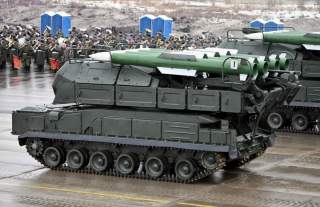Syria and the S-400: The Most Dangerous Game of Cat and Mouse on Earth
Could the S-400 potentially shoot down U.S. war planes?
Another way of saturating an air-defense battery would be to target it with long-range cruise missiles. As these are generally programmed to hit a specific location, they are not ideal for hunting a mobile weapon system such as the S-300 or -400. Furthermore, the S-400 is designed to shoot down cruise missiles, albeit not at the maximum 250-mile range. However, a barrage of missiles might catch a battery before it can react, or at least saturate it with targets, forcing it to choose between staying and place and firing back, or abandoning its firing position.
Lastly, the U.S. Navy could employ its EA-18G Growlers—modified F-18 Super Hornets equipped with ALQ-99 jamming pods—to suppress a battery’s radars. While Growlers by themselves might not completely shut down hostile radar, they could significantly degrade detection and targeting ranges, allowing the other platforms, including stealth fighters, to get close enough to deliver their weapons. The Growlers can also carry HARM missiles, and are being upgraded to share sensor data in order to generate faster targeting solutions against hostile radars.
Air-defense and counter-air-defense tactics entail an extremely complex game of cat and mouse. However, the key point to remember regarding the Russian SAMs in Syria is simple. Neither side has anything to gain from a U.S.-Russia shooting war over Syria, and it would be insane to deliberately start one. Thus, the primary concern should remain how to avoid triggering one by accident. This is not reassuring, given the intensity of Russian and U.S. operations in Syria and the frequency of accidents and near-misses so far by both sides’ aircraft. The move to formally reopen communications channels that nominally broke down last week is vital for mitigating those risks.
Sébastien Roblin holds a master’s degree in conflict resolution from Georgetown University and served as a university instructor for the Peace Corps in China. He has also worked in education, editing and refugee resettlement in France and the United States. He currently writes on security and military history for War Is Boring.
Image: Wikimedia Commons

